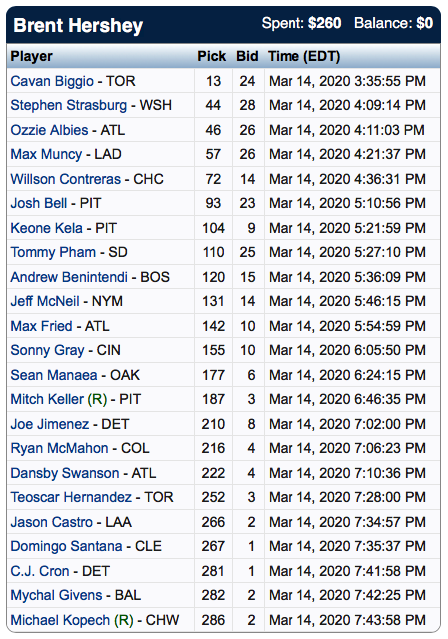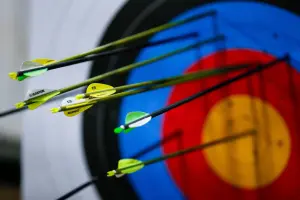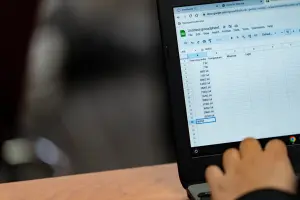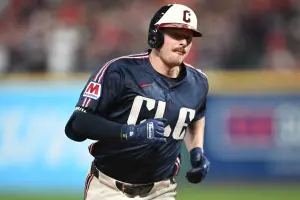
(*) ROTISSERIE: 2020 Tout Wars Mixed Auction — Taking it online
Like just about every other aspect of our lives in the past 10 days or so, the COVID-19 pandemic reached out and touched Tout Wars weekend. As probably most are now aware, the highly-anticipated industry weekend draftfest moved all of its traditionally live events to the internet for 2020.
As a participant in the Mixed Auction league, I found the online setting challenging in several respects. First, the interactivity of an auction just works so much better when all of the owners are physically in the same room. And it’s not just the banter, and the deep friendships that get rekindled and strengthened each year, but observing the actual owner actions and reactions in real time as players are nominated, bid on, sweated through the countdown, and ultimately acquired. You get to learn so much about your competitors—and hopefully, your friends—in live situations like this.
The second challenge is the specific mechanics. No matter how good an online draft-room auction software is—and there were amazingly few glitches in the Fantrax platform we used for Tout through the weekend—it’s still one more layer of technology to manage for each owner. Simply getting a feel for how it works is one thing. You want to have that down, since for participants in this case Tout Wars is a high-profile league. But often a second issue is that many of us (yours truly included) were also managing the auction with some other sort of technology (the great RotoLab in my case). That meant being attuned to two digital touchpoints, both of which were supposed to make this whole process as easy and simple as possible.
But now several days removed from the weekend, I realize that the coronavirus crisis assisted me in understanding better something that I've become increasingly aware of for a while. That is, how we often go about evaluating auction results is easily misconstrued and can easily be misleading. Let me explain.
I want to make clear I’m not immune from this in the least—so go ahead and fire up that Twitter search engine, you'll have a pile of "gotchas" from my feed in short order. But all over social media, while a draft is going on, and afterward, you’ll encounter references like these: Owner A got “the steal of the draft” with a specific $1 player. Owner B “grossly overpaid” for a mid-rotation starter. Owner C must be "out of his mind" to spend $55 on Mike Trout. And so on. While playing the armchair GM never gets old—heck, it's this hobby's core, right?—the broader implication with comments like these are that each player's “value” is one fixed (bid) number. And to deviate one way or the other from that number in the midst of your draft will be the sole element to make or break your fantasy season.
The reality is that most times in an auction, the context of the specific room is not given enough (any?) credence. Factors such as nomination order, remaining budget and positional concerns for each team, in-draft pricing dynamics (and more) all play a significant role in what determines a player's sale price. All of these things would come into play even IF all the owners agreed on one set of values for each player. But when you add in 12 or 15 different valuation systems, the concept of “value” in terms of acquisition price vs. expected statistical return quickly loses all relevance.
Now, one caveat: in a keeper league situation, where the player’s salary becomes some sort of baseline for a multi-year trajectory in a league, then yes, “value” is a worthy consideration. But in a one-year league—such as Tout Wars—evaluating the player’s acquisition price has much, much less relevance. While the $260 auction dollars is certainly the resource by which you acquire these 23 players, there are no long-term consequences on who you get for those 23 slots. Once your roster is set, that’s your team you leave the draft table with—so the goal should be putting together the best squad regardless of individual prices. Sometimes, it seems like we want to award the team that extracted the most "value" from its players. All of this before the season even starts, mind you.
So how does this all relate to my 2020 Tout Wars team? Well, both during and after the draft, the Fantrax software offered a view of teams as they were being rostered that had no prices attached. And I found that refreshing: let me see just WHO I (and other teams) rostered, without any distraction on HOW players got there. This one view helped downplay the temptation to only talk about “value” in terms of the prices I paid for each player. So for now, let's view my finished team in that light, allowing us to just evaluate the PLAYERS that my $260 bought me:

Of course, league context is important: this is a 15-team, 5x5 rotisserie league that uses on-base percentage instead of batting average. Trading is allowed, and after the auction, we snake draft our 6-spot reserve roster. In that exercise, I selected, in order: Hunter Harvey, Carter Kieboom, Kyle Gibson, Kyle Lewis, Emilio Pagán, and Zach Eflin.
A couple days past the fact, here are my observations on this team:
- On first glance, it seems it could be short on HR; there’s no proven, elite-level slugger among my hitters. Indeed, we project C.J. Cron as this team’s HR leader.
- On the other hand, the offense is filled with players who mostly project to full-time play. If the projections are close, this will result in a high number of team AB, something a certain staff member will likely take notice of.
- There’s a quintet of Baseball Forecaster UP plays here (Bell, Albies, Pham, Santana, Swanson), which increase our chances of a player significantly outperforming his projection.
- On the pitching side, there’s some more risk: several of my starters have shaky health grades, and the two SP on reserve are matchup plays only.
- Because of the risk, my projected ratios are higher than I would like—the risky pitchers also have some upside; such is the nature of the beast here.
- I did roster three closers, but with each, there’s some reason to question each of their longevity. Harvey, though, in the reserve portion, is a natural-backup flyer for Givens.
On the whole, I feel like this is a solid club overall (more so on offense than pitching) and looking at just the names provides a simpler post-draft evaluation. Sometimes, the bid numbers just get in our way.
Of course, I know that I won’t get away without revealing the acquisition prices for the team, so that comes below. But … in another twist from the Fantrax software, let's at the prices in somewhat of a different manner. Fantrax has a “By Team” view in their draft room which adds some important context to the "normal" grid + price view. This view better helps tell the story of how a team truly came together in an auction. Here's how mine looked afterwards:

(Both of these roster views for the entire league, plus an entire buy-by-buy order, is viewable on the Fantrax page here. Toggle the radio buttons at the top of that page for the different views.)
My roster is listed in order of acquisition, complete with the timestamp of when the player was “sold” (far right column). The “pick” column is the nomination order—so those numbers run from 1 to 345 (15 teams x 23 roster slots) for this draft . And the “bid” of course, is the player’s acquisition price. Several fascinating bits of information can be gathered about my team construction from this one chart:
Cavan Biggio was my first buy, and he was thrown out for nomination much, much earlier than one would expect (13 overall, approximately 20 minutes into the draft, which started at 3:15 ET). Going in, I was interested in Biggio in a league like this because of his bb% history, his HR/SB combination, as well as knowing that the 2B position was shallow this year. But no one, of course, has him rated as some sort of cornerstone piece.
But early on, money was flying off the board (four players out of the first 11 nominated fetched $50 or more!), as superstar after superstar found a home. The nomination of Biggio (I don't recall which owner it was, but wasn't me) was a definite change-of-pace move. After some mild back-and-forth, I was quite satisfied to roster him at a relatively modest $24 price.
Strasburg was my highest-priced player at $28, and someone I had no intention of targeting at that price. The way money was being spent, I had no worries about the bid going past me when I uttered "$28." But then it stopped—and I had my first pitcher. Strasburg had bypassed my budget for what I wanted to pay for my SP1, which was $25—but with several of the highest-rated starters sold for $34+, I figured things could have have been worse. I quickly attempted to scratch out my contingency plan.
I was still in my budget-adjusting mode, when Ozzie Albies as thrown two players later. I’ve been a huge fan of Albies’ 2020 potential since seeing his Forecaster box last fall, and he was one who I definitely targeted beforehand. It was at this point where the draft was going fast, and I was still getting used to the Fantrax/RotoLab/looking ahead rhythm. Luckily I able to push my Strasburg regret aside and pick up Albies, which along with Biggio, I knew gave me a nice base of MIF SB sources to work from.
As they always do, prices eventually came back to earth as the auction proceeded. Then for me, the job becomes to not just spring for the “bargain” players who stall far short of the RotoLab evaluation. There are just too many of them. But rather, I attempt to find the confluence of bargains who are also on my “target” list—players I like this season for whatever reason. Thus, the buys on Bell, Benintendi, Gray, and McMahon.
The chart above also reveals several elements from the end game:
- As I prefer to do when possible, I kept my $1 players to a minimum—two, in this case. What that means is that when we hit that final stage, I was able to acquire several more loose “targets” in positions I needed to fill, with one eye on my roster, and one on my remaining dollars. So for Swanson and Hernandez, I was able to outbid those not willing or able to go higher. In Castro’s case, I felt I had wrongly passed on several second catchers earlier on, but liked Castro’s mix of OBP, playing-time projections, and positive spring hard-hit reports much better than anything left in the catcher pool at that point. So when he was nominated for $1 by someone who only had $1/player left, I could jump in and get him for $2.
- For the next two throws, I was able to secure Santana and Cron for crickets. In each case, I had the ability to go to $3 if someone else jumped in, but didn't need it, and it set me up for my final two buys.
- Givens was not all on my radar coming in, but I noticed he was still there in the end game. I made myself a note that depending on how things developed, he could be a decent cheap add (since he has the closer job as far as we know) to my shaky Kela/Jiminez saves duo. When someone else tried to sneak him through at $1, I was able to top for $2.
- And then the end … with $2 left to spend and most competitors well into Dollar Days, Kopech was definitely an end-game target. Had the nomination turn got to me, I would likely have nominated Kopech for $2 and finished up. So it was some good virtual drama when good friend Ron Shandler threw him out at $1, I hesitated (only slightly) before bidding $2, effectively locking up Kopech and ending my draft in one fell swoop. I must say, though, that the Bearded One was not impressed.
In the end, I was satisfied that I met a loose goal that I often consider but have never executed in Tout Wars Mixed Auction: to field a balanced team that includes no buys of $30 or more. I know that to both achieve that in March and also be competitive come August, there has to be the right mix draft-day discipline, in-season flexibility, and, of course, a dash of good luck.
Here's hoping that we get to see if it worked.
Feel free to leave comments on the squad, evaluating a list without bid results or anything else in the comments below.








